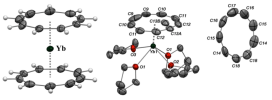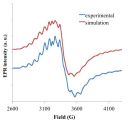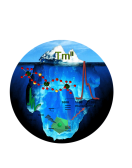
Nocton Research group
Organometallics for Sustainable Chemistry and Quantum Technologies


© Grégory Nocton - Personal website - gregory.nocton.at.polytechnique.edu

Organometallics for Quantum Technologies
Organometallics for Sustainable Chemistry


Organolanthanides and Single Molecules Magnets (RelaxMax)
This project was granted by the ANR in 2019. The objective of the project is the specific design and the synthesis of organometallic complexes of lanthanides that possess slow magnetic relaxation properties with high blocking temperature. The use of the typical ligands used in organometallic chemistry is proposed herein (Cp), (Cot). The use of the cyclononatetraenyl (Cnt) ligand, a large mono-anionic Huckël-aromatic ligand is also proposed: it will lead to unique geometric features in both divalent and trivalent lanthanide chemistry.
Photochemical hydrogen production from food wastes
This project is performed in collaboration with Dr. Grégory Danoun and Dr. Cédric Tard. The objectif is to use the specific design of new dual catalysts to produce hydrogen from molecules contained in food wastes. Alcohols, long chain carbon carboxylic acids and urea are prime targets.
Xemard et al. Dalton Trans., 2018

Small Molecule Activation: Atom Economy and Sustainable Processes
We aim at reacting our novel complexes with small molecules, such as nitrogen, carbon dioxide, nitrogen protoxyde, white phosphorus and carbon monoxide in order to lean toward their transformation in more valuable products.
Goudy et al. J. Am. Chem. Soc. 2017, 139, 10633 / Jaoul et al. Chem. Squ., 2019, 3, 1 / Goudy et al. Inorganics, 2018, 6, 82.

Many thanks to all these agencies for financial support






Gianetti et al. Chem. Sci., 2015, 6, 993-1003 / Gianetti et al. J. Am. Chem. Soc. 2013, 135, 3224-3236 / Cao et al. Angew. Chem. Int. Ed., 2014, 53, 1368-1372.


Xémard et al. Angew. Chem. Int. Ed., 2017, 54, 4266 / Jaoul et al. New J. Chem., 2016, 8, 6643/ Jaoul et al. Chem. Phys. Chem., 2017, 18, 2688 / Xémard et al. J. Am. Chem. Soc., 2018, 140, 14443.

Building new Optical Active Materials for Selective P-S and P-O Hydrolysis
We consider the use of divalent lanthanides complexes as starting materials to build large trivalent soluble assemblies that may be used as catalysts for selective P-S or P-O hydrolysis. These new clusters may also be used as precursors for the formation of nanomaterial containing lanthanides for a variety of applications.
Quantum Bits and Long Relaxation Organometallics
The investigation of the unusual electronic structure of coordination compounds and organometallics is a topic of great interest for us. We use X-ray studies, magnetism, EPR, NMR, optical spectroscopy and theoretical analyses with the objective to develop molecules with potential application in quantum technologies
Heterobimetallic Complexes for C-H activation (LanAsCat)
This is an ERC granted project that aims at developing a new type of organometallics containing lanthanides, redox non-innocent ligands and transitions metals is herein proposed: the first providing reversible electron(s) source(s) (remote control), the second acting as electron(s) reservoir and controlling the electron correlation strength (“dimmer switch”), and the last being the site of the selective catalytic reaction. The principal goal is to synthesize active compounds with respect to C-H bonds activation and methane activation is regarded as an ultimate achievement. It is our main research focus until 2022.
Electron Transfer Reactivity of Organolanthanides (ReDivaLan)
This project was an ANR (Agence National de la Recherche) funded projet that ended in 2018 that aimed at drawing a relation between the odd electronic structure of organolanthanides and their unusual reactivity: it was a collaborative grant together with O. Maury (ENS Lyon), C. Clavaguéra (Orsay University) and L. Maron (INSA Toulouse). We are now expending the concept for the design of Single Molecules Magnets
Original Low- and High Valent Organometallics: Intermediate Valent States and Phi Bonding
We design soluble and original organometallic complexes of low- and high valent transitions metals and of lanthanides. These soluble complexes may be used as precursors for further reactivity or for the synthesis more elaborated molecules containing redox active ligands. We are interested in original bonding: multiconfigations, delta and phi back-bonding.